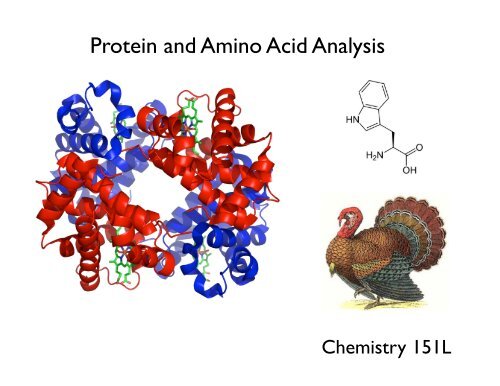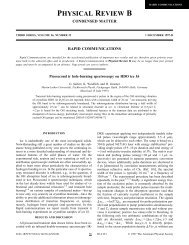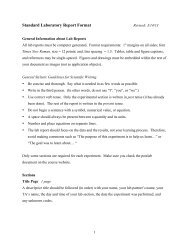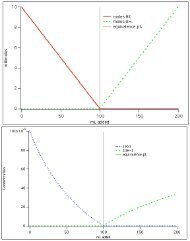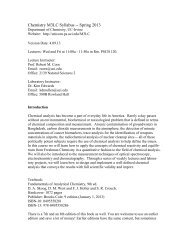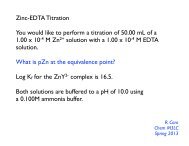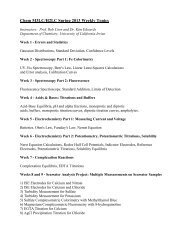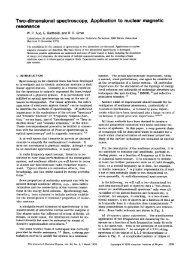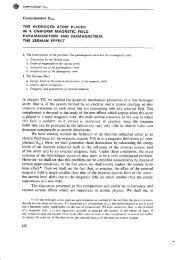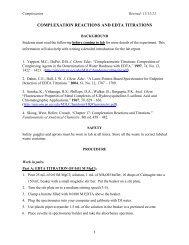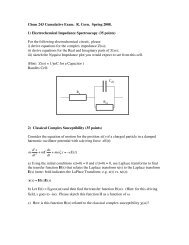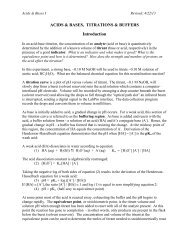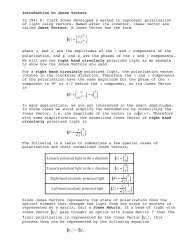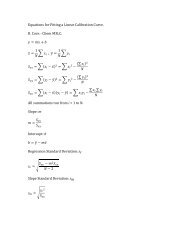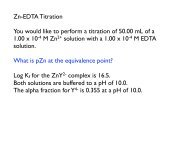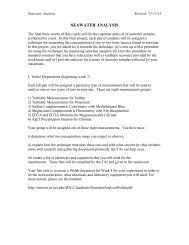Protein and Amino Acid Analysis - The Corn Group Unicorn Web Site
Protein and Amino Acid Analysis - The Corn Group Unicorn Web Site
Protein and Amino Acid Analysis - The Corn Group Unicorn Web Site
Create successful ePaper yourself
Turn your PDF publications into a flip-book with our unique Google optimized e-Paper software.
<strong>Protein</strong> <strong>and</strong> <strong>Amino</strong> <strong>Acid</strong> <strong>Analysis</strong><br />
Chemistry 151L
<strong>Protein</strong>s<br />
<strong>Protein</strong>s are made up of amino acids:<br />
H2N-CHR-COOH +<br />
H3N-CHR-COO -<br />
neutral form<br />
zwitterionic form
<strong>The</strong>re are twenty st<strong>and</strong>ard amino acids:<br />
A ala alanine<br />
R arg arginine<br />
N asn asparagine<br />
D asp aspartic acid<br />
C cys cysteine<br />
Q gln glutamine<br />
E glu glutamic acid<br />
G gly glycine<br />
H his histidine<br />
I ile isoleucine<br />
L leu leucine<br />
K lys lysine<br />
M met methionine<br />
F phe phenylalanine<br />
P pro proline<br />
S ser serine<br />
T thr threonine<br />
W trp tryptophan<br />
Y tyr tyrosine<br />
V val valine
<strong>The</strong>re are twenty st<strong>and</strong>ard amino acids:<br />
A ala alanine<br />
R arg arginine<br />
N asn asparagine<br />
D asp aspartic acid<br />
C cys cysteine<br />
Q gln glutamine<br />
E glu glutamic acid<br />
G gly glycine<br />
H his histidine<br />
I ile isoleucine<br />
L leu leucine<br />
K lys lysine<br />
M met methionine<br />
F phe phenylalanine<br />
P pro proline<br />
S ser serine<br />
T thr threonine<br />
W trp tryptophan<br />
Y tyr tyrosine<br />
V val valine
<strong>The</strong>re are twenty st<strong>and</strong>ard amino acids:<br />
A ala alanine<br />
R arg arginine<br />
N asn asparagine<br />
D asp aspartic acid<br />
C cys cysteine<br />
Q gln glutamine<br />
E glu glutamic acid<br />
G gly glycine<br />
H his histidine<br />
I ile isoleucine<br />
L leu leucine<br />
K lys lysine<br />
M met methionine<br />
F phe phenylalanine<br />
P pro proline<br />
S ser serine<br />
T thr threonine<br />
W trp tryptophan<br />
Y tyr tyrosine<br />
V val valine
<strong>The</strong>re are twenty st<strong>and</strong>ard amino acids:<br />
A ala alanine<br />
R arg arginine<br />
N asn asparagine<br />
D asp aspartic acid<br />
C cys cysteine<br />
Q gln glutamine<br />
E glu glutamic acid<br />
G gly glycine<br />
H his histidine<br />
I ile isoleucine<br />
L leu leucine<br />
K lys lysine<br />
M met methionine<br />
F phe phenylalanine<br />
P pro proline<br />
S ser serine<br />
T thr threonine<br />
W trp tryptophan<br />
Y tyr tyrosine<br />
V val valine
<strong>The</strong>re are twenty st<strong>and</strong>ard amino acids:<br />
A ala alanine<br />
R arg arginine<br />
N asn asparagine<br />
D asp aspartic acid<br />
C cys cysteine<br />
Q gln glutamine<br />
E glu glutamic acid<br />
G gly glycine<br />
H his histidine<br />
I ile isoleucine<br />
L leu leucine<br />
K lys lysine<br />
M met methionine<br />
F phe phenylalanine<br />
P pro proline<br />
S ser serine<br />
T thr threonine<br />
W trp tryptophan<br />
Y tyr tyrosine<br />
V val valine
<strong>The</strong>re are twenty st<strong>and</strong>ard amino acids:<br />
A ala alanine<br />
R arg arginine<br />
N asn asparagine<br />
D asp aspartic acid<br />
C cys cysteine<br />
Q gln glutamine<br />
E glu glutamic acid<br />
G gly glycine<br />
H his histidine<br />
I ile isoleucine<br />
L leu leucine<br />
K lys lysine<br />
M met methionine<br />
F phe phenylalanine<br />
P pro proline<br />
S ser serine<br />
T thr threonine<br />
W trp tryptophan<br />
Y tyr tyrosine<br />
V val valine
<strong>The</strong>re are twenty st<strong>and</strong>ard amino acids:<br />
A ala alanine<br />
R arg arginine<br />
N asn asparagine<br />
D asp aspartic acid<br />
C cys cysteine<br />
Q gln glutamine<br />
E glu glutamic acid<br />
G gly glycine<br />
H his histidine<br />
I ile isoleucine<br />
L leu leucine<br />
K lys lysine<br />
M met methionine<br />
F phe phenylalanine<br />
P pro proline<br />
S ser serine<br />
T thr threonine<br />
W trp tryptophan<br />
Y tyr tyrosine<br />
V val valine<br />
Tryptophan
Tryptophan<br />
A common belief is that heavy consumption of turkey meat (as for example in a<br />
Thanksgiving or Christmas feast) results in drowsiness, which has been attributed<br />
to high levels of the amino acid tryptophan contained in turkey. While turkey does<br />
contain high levels of tryptophan, the amount is comparable to that contained in<br />
most other meats. Furthermore, postpr<strong>and</strong>ial Thanksgiving sedation may have more<br />
to do with what else is consumed along with the turkey, in particular<br />
carbohydrates <strong>and</strong> alcohol.<br />
Tryptophan
Peptides<br />
<strong>The</strong> amino acids can be linked together with peptide bonds:<br />
amide linkage
<strong>Protein</strong>s<br />
<strong>Protein</strong>s are made up of many amino acids linked together<br />
with many peptide bonds.
<strong>Protein</strong> <strong>Analysis</strong><br />
<strong>Protein</strong>s fold into useful structures.<br />
An example: Cytochrome C<br />
Cytochrome c is an electroncarrying<br />
mitochondrial protein. <strong>The</strong><br />
transition of cytochrome c between<br />
the ferrous <strong>and</strong> ferric states within<br />
the cell makes it an efficient<br />
biological electron-transporter. It<br />
plays a vital role in cellular oxidation<br />
in both plants <strong>and</strong> animals, <strong>and</strong> is<br />
generally regarded as a universal<br />
catalyst of respiration.<br />
x-ray crystal<br />
structure
<strong>Protein</strong> <strong>Analysis</strong><br />
<strong>Protein</strong>s fold into useful structures.<br />
An example: Cytochrome C<br />
Molecular mass:<br />
12,233 Da (Human Cyt c)<br />
Residue Sequences:<br />
Human:<br />
mgdvekgkki fimkcsqcht vekggkhktg<br />
pnlhglfgrk tgqapgysyt aanknkgiiw<br />
gedtlmeyle npkkyipgtk mifvgikkke<br />
eradliaylk katne<br />
x-ray crystal<br />
structure<br />
Fruit Fly:<br />
mgvpagdvek gkklfvqrca qchtveaggk<br />
hkvgpnlhgl igrktgqaag faytdankak<br />
gitwnedtlf eylenpkkyi pgtkmifagl<br />
kkpnergdli aylksatk
<strong>Protein</strong> <strong>Analysis</strong><br />
Cytochrome C transports oxygen <strong>and</strong> electrons<br />
with Fe-containing heme groups:<br />
heme group<br />
Fe 2+ or Fe 3+
<strong>Protein</strong>s<br />
Another example: Hemoglobin<br />
Hemoglobin (abbreviated Hb or<br />
Hgb) is the iron-containing oxygentransport<br />
metalloprotein in the red<br />
blood cells of vertebrates, <strong>and</strong> the<br />
tissues of some invertebrates.<br />
In mammals, the protein makes up<br />
about 97% of the red blood cell’s<br />
dry content, <strong>and</strong> around 35% of the<br />
total content (including water).<br />
Hemoglobin transports oxygen from<br />
the lungs or gills to the rest of the<br />
body (i.e. the tissues) where it<br />
releases the oxygen for cell use.
<strong>Protein</strong>s<br />
Another example: Hemoglobin<br />
In adult humans, the most common<br />
hemoglobin type is a tetramer<br />
called hemoglobin A, consisting of<br />
two α <strong>and</strong> two β structurally<br />
similar subunits non-covalently<br />
bound, each made of 141 <strong>and</strong> 146<br />
amino acid residues, respectively.<br />
Each subunit is composed of a<br />
protein chain tightly associated with<br />
a non-protein heme group. Each<br />
subunit has a molecular weight of<br />
about 17,000 daltons, for a total<br />
molecular weight of the tetramer of<br />
about 68,458 daltons.
Why do we need people who know about Analytical Chemistry?
Kjeldahl method<br />
<strong>Protein</strong> <strong>Analysis</strong><br />
<strong>The</strong> classic assay for protein concentration in food<br />
is the Kjeldahl method. This test determines the<br />
total nitrogen in a sample. <strong>The</strong> only major<br />
component of most food which contains nitrogen<br />
is protein (fat, carbohydrate <strong>and</strong> dietary fibre do<br />
not contain nitrogen). If the amount of nitrogen is<br />
multiplied by a factor depending on the kinds of<br />
protein expected in the food the total protein can<br />
be determined. On food labels the protein is given<br />
by the nitrogen multiplied by 6.25, because the<br />
average nitrogen content of proteins is about 16%.<br />
<strong>The</strong> Kjeldahl test is used because it is the method<br />
the AOAC International has adopted <strong>and</strong> is<br />
therefore used by many food st<strong>and</strong>ards agencies<br />
around the world.
2008 Chinese Melamine Sc<strong>and</strong>al<br />
<strong>Protein</strong> <strong>Analysis</strong>
2008 Chinese Melamine Sc<strong>and</strong>al<br />
<strong>Protein</strong> <strong>Analysis</strong><br />
In 2008, thous<strong>and</strong>s of babies in China became ill, having suffered acute kidney failure, with several<br />
fatalities, having been fed formula milk contaminated with the industrial chemical melamine.<br />
On 17 September 2008, Health Minister Chen Zhu stated that tainted milk formula had<br />
"sickened more than 6,200 children, <strong>and</strong> that more than 1,300 others, mostly newborns, remain<br />
hospitalised with 158 suffering from acute kidney failure". By 23 September, about 54,000<br />
children were reported to be sick <strong>and</strong> 4 had died. An additional 10,000 cases were reported<br />
from the provinces by 26 September. A WHO official said 82 percent of the children made ill<br />
were 2 years of age or below. <strong>The</strong> Hong Kong Centre for Food Safety said that 99% of victims<br />
were aged under 3 years. Ten Hong Kong children were diagnosed with kidney problems, at least<br />
four cases were detected in Macau, <strong>and</strong> six in Taiwan.<br />
Manufacturer, Sanlu, part-owned by New Zeal<strong>and</strong>’s Fonterra Cooperative, recalled all of its<br />
powdered milk products in China’s north-west province of Gansu. However, twenty-two br<strong>and</strong>s,<br />
including China Mengniu Diary Co <strong>and</strong> Inner Mongolia Yili Industrial <strong>Group</strong>, of milk powder were<br />
quickly identified as containing melamine. “<strong>The</strong> majority of afflicted infants ingested Sanlu-br<strong>and</strong><br />
milk powder over a long period of time, their clinical symptoms showed up three to six months<br />
after ingesting the problematic products,” Health Minister Chen Zhu told Bloomberg Asia.<br />
So, what is melamine <strong>and</strong> how does it spoof the protein levels in baby formula milk?
<strong>Protein</strong> <strong>Analysis</strong><br />
Melamine<br />
C3H6N6<br />
Melamine is an organic compound with<br />
chemical formula C3H6N6. Officially it is<br />
1,3,5-triazine-2,4,6-triamine in the IUPAC<br />
nomenclature system. It is has a molecular<br />
mass of just over 126, forms a white,<br />
crystalline powder, <strong>and</strong> is only slightly<br />
soluble in water. It is used in fire<br />
retardants in polymer resins because its<br />
high nitrogen content is released as flamestifling<br />
nitrogen gas when the compound<br />
is burned or charred.<br />
It is its high nitrogen level – 66% nitrogen<br />
by mass – that gives melamine the<br />
analytical characteristics needed to fake<br />
the nitrogen in protein samples.<br />
<strong>The</strong> world needs to use better methods for measuring protein<br />
content!!! This sc<strong>and</strong>al should have never happened. :(
Why do we need to eat Turkey?
<strong>Protein</strong> Consumption<br />
Most health groups insist on you eating protein daily! Turkey<br />
is usually on the list:
<strong>Protein</strong> Consumption<br />
Why do we eat protein? <strong>The</strong> following are "Essential <strong>Amino</strong><br />
<strong>Acid</strong>s," amino acids that we can not synthesize ourselves.<br />
RDAs
<strong>Protein</strong> Consumption<br />
Limiting <strong>Amino</strong> <strong>Acid</strong>s: Stoichiometry applied to eating.<br />
What type of protein should we eat? Our bodies use amino acids in a specific<br />
ratio to each other, so if a person doesn’t get enough of one of them to<br />
match with the rest, the rest can only be used at a level to balance with that<br />
low one. Most of these amino acids are fairly easy to get in a reasonably wellbalanced<br />
diet. However, if you only get protein from one source, you could be<br />
limited by the specific amino acid content of your food. Stoichiometrically<br />
limited! <strong>The</strong> three most typical limiting amino acids include the two sulfurcontaining<br />
amino acids (methionine <strong>and</strong> cysteine), tryptophan, <strong>and</strong> lysine.
Turkey has plenty of all of the various<br />
amino acids, <strong>and</strong> lots of protein. So enjoy!<br />
Data for a 100g sample.
Happy Thanksgiving!<br />
See you next Monday!


